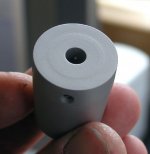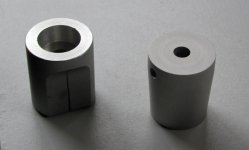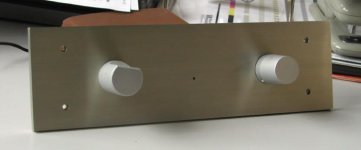Either cast...or made on a very very worn out lathe. It would look like that when the cutting tool gets close to the center.
Isnt it too little to be noticed when mounted?
Magura🙂
Isnt it too little to be noticed when mounted?
Magura🙂
Its sure machined on a worn out lathe. Note the direction of the tool movement when running the Y axis, the center protrudes a bit on the back....and thats mirrored on the front.
Thats all good news though, a cast button is not to wish for. The pourousity of the cast attracts all kinds of unwishfull stuff, like grease (from hands) and so forth, and its almost impossible to clean.
Magura🙂
Thats all good news though, a cast button is not to wish for. The pourousity of the cast attracts all kinds of unwishfull stuff, like grease (from hands) and so forth, and its almost impossible to clean.
Magura🙂
And here's comparison with the other knob. On Indian knob, you can't see any marks from tooling, it's completely washed out.
While on the other knob, every cut line is visible (on the other side).
The front surface irregularity on Indian knob is not that obvious, and is visible only at certain angle (and light). I wouldn't be concerned with that.
While on the other knob, every cut line is visible (on the other side).
The front surface irregularity on Indian knob is not that obvious, and is visible only at certain angle (and light). I wouldn't be concerned with that.
Attachments
He have obviously covered up for the old lathe by ball blasting quite heavily. Thats also not to lay awake at night about....quite common practice in the industry.
Looks like the two knobs are not made on the same lathe though ??
Magura🙂
Looks like the two knobs are not made on the same lathe though ??
Magura🙂
The other knob is made in Canada, and it was used on older Classe preamp.
Since there was an interest in that designed, I asked a local manufacturer for production run. They agreed and asked first that sample be made to see if it's up to quality of original one (it's quite complicated design and they don't want to take any chances). The single sample is CAD$200. I agreed to that.
The price of the finished knob would be at least USD$12/pc. max $15, depending on final estimate. I would go with 100pcs in first run.
Now we have those Indian knobs (or actually we had them before), so it's up to people to decide, what they prefer. I could offer both knob designs with a chassis, and if the Indian production is much cheaper, that what I have, they might be a popular item.
The other problem is the incompatibility with imperial system, as I'm using 1/4 (1/2 OD) plastic washers as shaft gides, and I don't really see where I could get the ones to fit 6mm shafts and still be 1/2" outer diameter.
Since there was an interest in that designed, I asked a local manufacturer for production run. They agreed and asked first that sample be made to see if it's up to quality of original one (it's quite complicated design and they don't want to take any chances). The single sample is CAD$200. I agreed to that.
The price of the finished knob would be at least USD$12/pc. max $15, depending on final estimate. I would go with 100pcs in first run.
Now we have those Indian knobs (or actually we had them before), so it's up to people to decide, what they prefer. I could offer both knob designs with a chassis, and if the Indian production is much cheaper, that what I have, they might be a popular item.
The other problem is the incompatibility with imperial system, as I'm using 1/4 (1/2 OD) plastic washers as shaft gides, and I don't really see where I could get the ones to fit 6mm shafts and still be 1/2" outer diameter.
The indian knobs are not bad looking at all. Peter, do you have a complete box that you can try both of them on? Just on the front plate, they seem a bit big for where they're placed.
6mm is bigger than 1/4, so you could just have them drilled in a lathe....that cant be too expensive.
Magura🙂
EDIT:
Sure the indian knobs seem big...but just look at PD's fingers....the knobs are not that big in real life 🙂
Magura🙂
EDIT:
Sure the indian knobs seem big...but just look at PD's fingers....the knobs are not that big in real life 🙂
IMHO the indian knob matches the face plate better than the classe one, some what more classy, cleaner look..
Chris
Chris
Indian knobs seem to add more modern look and Classe seems to be more "professional", business like look.
I tend to prefer Classe too, but I don't dismiss Indian ones.
The other drawback with them is lack of any (position) indicator, and when it's done afterwards, it may not look that clean.
Unfortuantely I was sent only one knob. They must be quite expensive apparently😉
I tend to prefer Classe too, but I don't dismiss Indian ones.
The other drawback with them is lack of any (position) indicator, and when it's done afterwards, it may not look that clean.
Unfortuantely I was sent only one knob. They must be quite expensive apparently😉
For what it's worth, I vote for the Classe knobs as well. The chassis looks so nice that I'd hate to compromise at the 11th hour. (Although the alternative knobs aren't bad at all, just not my first choice).
Scott
Scott
A thought that just came to me.
Now that youre have the knobs custom made....make sure you order both the faceplate and the knobs made of the same type of aluminium.
If not you will see that some types of aluminium changes colour/reflection/appearance over time differently from other types. In some cases its quite significant.
Magura🙂
Now that youre have the knobs custom made....make sure you order both the faceplate and the knobs made of the same type of aluminium.
If not you will see that some types of aluminium changes colour/reflection/appearance over time differently from other types. In some cases its quite significant.
Magura🙂
I like either one but would like to be able to see visually postion of knob in relation to panel I.E. marking of some kind on knob
- Status
- Not open for further replies.
- Home
- Amplifiers
- Chip Amps
- Chassis for a group order of non-inverted GC kit?



